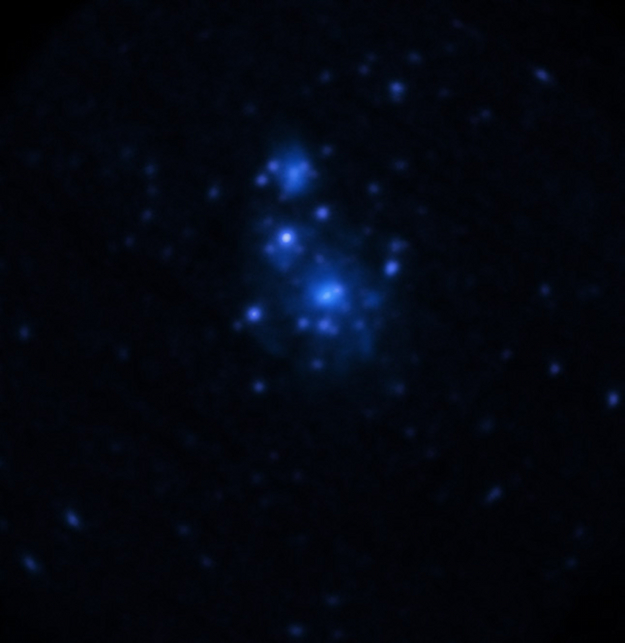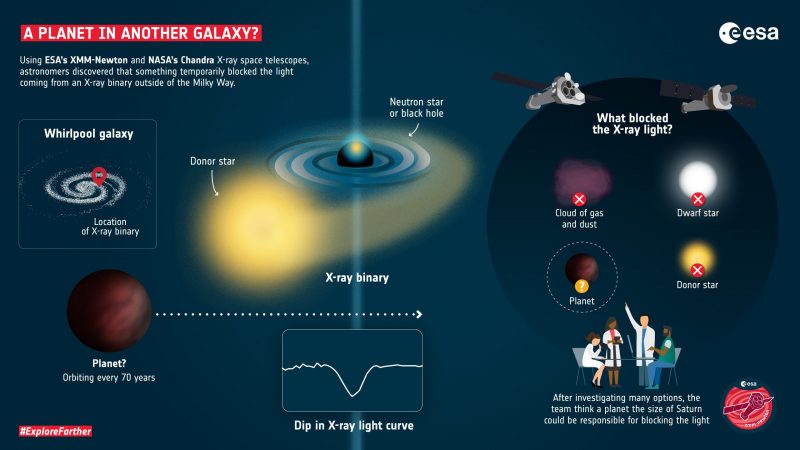
1st extragalactic planet?
A team of astronomers believes it might have detected the first planet beyond our Milky Way, in another galaxy far away. M51, the famous Whirlpool Galaxy, is located in the direction of our constellation Canes Venatici. At about 30 million light-years away, the Whirlpool Galaxy is close enough and huge enough to see with binoculars in a dark sky. But good luck picking out individual stars from the swirling mass of billions. So how could the astronomers spot a dim planet? The answer lies in X-ray data from a binary system, where an ordinary star orbits a neutron star or black hole. The astronomers observed a dip in brightness from the system. They believe the dip might indicate the first known extragalactic planet passing in front of the X-ray source.
The peer-reviewed journal Nature Astronomy published these scientists’ new study on October 25, 2021.
Looking for a planet in a distant galaxy is no easy task. Galaxies are great islands of billions of stars. Planets orbit stars, and are hidden in the stars’ glare. Plus a galaxy is such a small swath of light in our sky. It’s largely impossible for astronomers to see individual stars in optical light. However, X-ray light is a different story. Fewer objects shine in X-ray light, making individual objects easier to pinpoint. Note the image of the Whirlpool Galaxy in a combination of optical light and X-ray light, at top, followed by an image of the galaxy in X-rays only, below.

Targeting X-ray binaries
X-ray binaries are excellent targets for the search for extragalactic planets. In an X-ray binary, a neutron star or black hole feeds on material from its stellar companion, usually an ordinary star. The infalling material typically creates a disk around the black hole or neutron star. Energetic processes in and around the infalling star stuff, and the disk, produce X-rays. The idea here is that – in much the same way that many exoplanets in our own galaxy are found via the transit method (where a distant planet passes in front of a star, causing a dip in its light), so a planet in a distant galaxy might cause a dip in the observed light of a bright X-ray binary.
Lead author Rosanne Di Stefano from the Harvard Smithsonian Center for Astrophysics said:
X-ray binaries may be ideal places to search for planets, because, although they are a million times brighter than our sun, the X-rays come from a very small region. In fact, the source that we studied is smaller than Jupiter, so a transiting planet could completely block the light from the X-ray binary.
The team used X-ray data from the Chandra and XMM-Newton telescopes. It searched three galaxies before finding an intriguing candidate: the X-ray binary M51-ULS-1. The data revealed a dip – a complete blocking of the X-ray signal from this binary pair – for a approximately three hours.
Ruling out other possibilities
So the scientists found an extragalactic X-ray binary pair that had a 3-hour dip in its light. The dip might indicate a planet. But the team had to rule out other possible explanations. Di Stefano commented:
We first had to make sure that the signal was not caused by anything else. We did this by an in-depth analysis of the X-ray dip in the Chandra data, analyzing other dips and signals in the XMM data, and also modeling dips caused by other possible events, including a planet.
They considered whether gas or dust might be causing the blocking of the x-ray source and the dip. But the observed radiation suggests the blocking object has a well-defined surface. So an amorphous cloud doesn’t fit the bill.
Then, they considered some sort of dwarf star, say a red or brown dwarf, as a third object in the system and the possible culprit for causing the dip. But the binary system is too young, and the transiting object too large, for a dwarf star to be the explanation.
Next, they considered whether a variation in radiation from the source itself might explain the dip. But they ultimately said no to this possibility, too. That was because, despite the light from the source disappearing for a few hours, when it came back the temperature and colors were the same as before.
Lastly, they considered whether the star itself might be the source of the dip in light. They ruled this out, too, when they compared the suspected dip to another light blockage. When the companion star passed in front of the X-ray source, the blackout was much longer than the 3-hour dip. Di Stefano explained:
We did computer simulations to see whether the dip has the characteristics of a planet transiting, and we find that it fits perfectly. We are pretty confident that this is not anything else and that we have found our first planet candidate outside the Milky Way.
The game plan for finding an extragalactic planet

If it’s a planet, what’s it like?
Based on their observations, the team believes the planet would be similar in size to Saturn. It probably orbits the binary star system at a distance tens of times farther than the Earth-sun distance. They expect one orbit of the extragalactic planet to take roughly 70 Earth-years. The X-ray source would dose the planet with extreme amounts of radiation; therefore, it’s probably void of life as we know it.
Because the planet has an orbit of approximately 70 years, the scientists won’t be able to repeat the observations any time soon. Without repeat observations, the extragalactic planet will remain just a planet candidate for now. As Di Stefano said about their inability to make a confirmation:
We can only say with confidence that it doesn’t fit any of our other explanations.
If indeed it is an extragalactic planet, it would not only be the first of its kind, but also the first known planet around an X-ray binary system. And more discoveries may be in the works. Di Stefano said:
Now that we have this new method for finding possible planet candidates in other galaxies, our hope is that by looking at all the available X-ray data in the archives, we find many more of those. In the future we might even be able to confirm their existence.

Bottom line: Scientists believe they may have detected the first extragalactic planet by examining X-rays from a binary pair – likely a neutron star or black hole orbiting with an ordinary star – in the famous Whirlpool Galaxy.
Source: A possible planet candidate in an external galaxy detected through X-ray transit
The post The 1st extragalactic planet? first appeared on EarthSky.
0 Commentaires